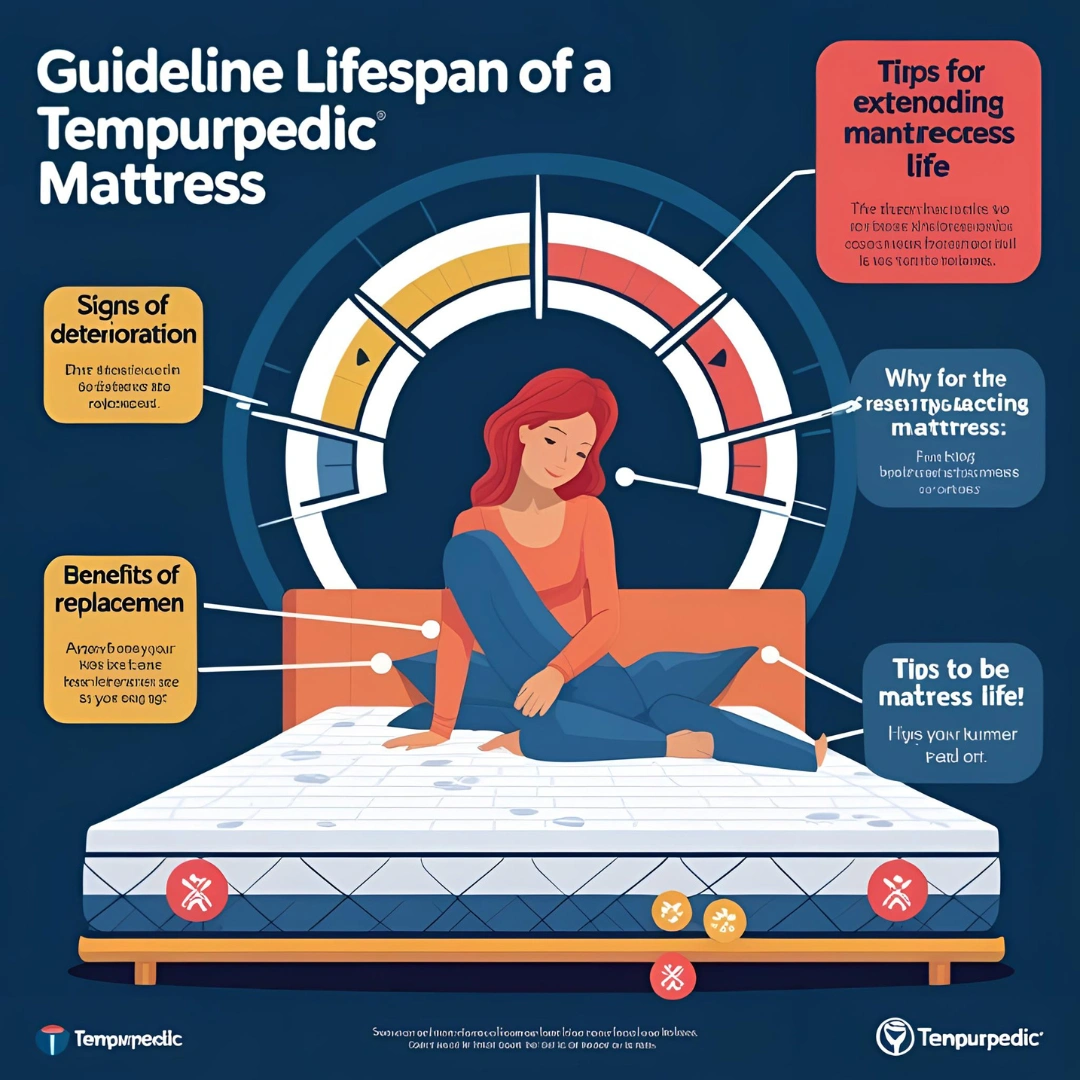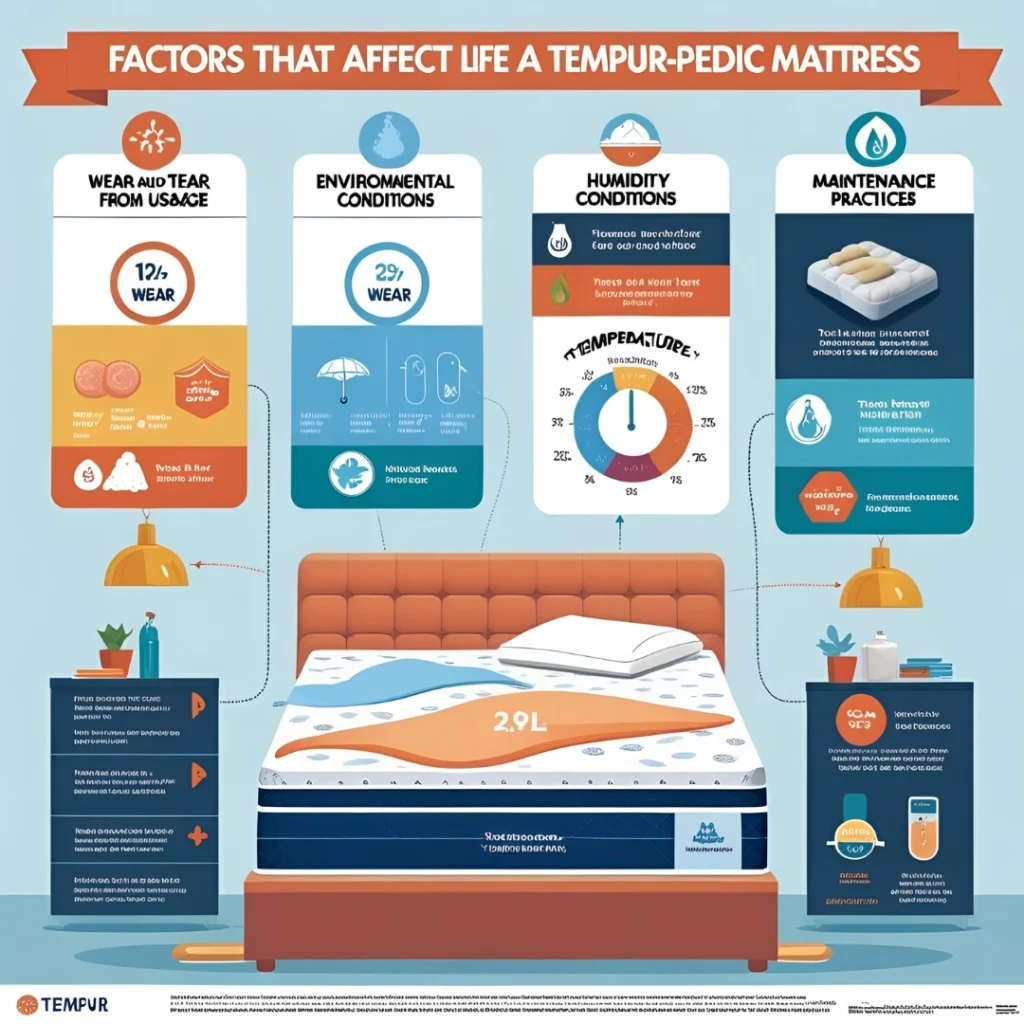I asked myself this question not long ago—how often should you replace your Tempur-Pedic mattress? Mine still looked okay, but I was waking up sore and tired. That’s when I realized it might be more worn out than I thought.
I’ve owned a Tempur-Pedic for years, and I’ve learned a lot about how long they last. In this guide, I’ll share what I found, plus a few signs it might be time for you to upgrade.
Let’s figure out if your mattress is still working for you—or holding you back from better sleep.
Why I Asked This Question Myself (My Tempur-Pedic Experience)
I started having back pain out of nowhere. At first, I blamed my office chair. Then I blamed my posture. But one morning, it hit me—what if it’s my mattress?
I had been sleeping on my Tempur-Pedic for nine years. It used to feel like a cloud. But lately, it felt more like a dent. I wasn’t waking up refreshed. I was waking up sore.
That’s when I started paying attention. I noticed I was tossing more. The foam wasn’t bouncing back. I felt like I was sinking too deep into the bed. It just didn’t feel right anymore.
So I did some research. I wanted to know the lifespan of a Tempur-Pedic mattress. The brand says 8–10 years. Mine was at year nine. It all started to make sense.
Quick answer: If you’re waking up sore, and your mattress is over 8 years old, it might be time for a change—even if it still looks fine.
What’s the Typical Lifespan of a Tempur-Pedic Mattress?
I used to think my Tempur-Pedic would last forever. It felt strong, supportive, and way better than my old spring bed. But when I hit year nine, it started feeling different—less firm, more sink.
Quick answer: The lifespan of a Tempur-Pedic mattress is usually 8 to 10 years, depending on how you use and care for it.
Tempur-Pedic says their mattresses are made to last around a decade. And in many cases, they do. But that depends on things like your weight, how often you sleep on it, and how well it’s protected.
Some people replace theirs after seven years. Others stretch it to twelve. I’ve seen both stories while digging through forums and review sites. But most people seem to agree—after 8 to 10 years, the support starts to fade.
Compared to regular memory foam beds, Tempur-Pedic does last longer. The foam is thicker and denser, so it holds up better. It also beats many hybrid mattresses when it comes to wear and tear.
A study from the Sleep Foundation notes that most memory foam beds last 7–10 years. Tempur-Pedic models land on the higher end of that scale because of better materials. Still, no mattress lasts forever.
Key takeaway: Even the best foam wears down over time. If your Tempur-Pedic is 8+ years old, check for sagging or sleep issues. That’s your cue to start thinking about a replacement.
Signs It’s Time to Replace Your Tempur-Pedic Mattress
I didn’t want to admit my mattress was the problem. It looked fine at first glance. But my body told a different story.
Quick answer: If your Tempur-Pedic mattress has sagging, causes new aches, or smells musty, it’s probably time to replace it—especially after 8+ years.
1. Sagging or Deep Indentations
I started seeing a dip right in the middle of my bed. It didn’t bounce back like it used to. Lying down felt like sinking into a soft valley. That’s a red flag for worn-out foam. This usually means the support layers have broken down.
2. Waking Up Sore or Stiff
I used to wake up refreshed. But over time, I felt more aches in my lower back and shoulders. Even a full night’s sleep didn’t leave me feeling rested.
If you’re waking up tired or sore, your mattress might not be doing its job anymore.
3. Less Motion Isolation
One thing I loved about my Tempur-Pedic was how it isolated movement. But later on, I noticed I could feel every time my partner turned over.
When motion transfer increases, it’s often a sign the memory foam is wearing out.
4. Musty Smell or Allergy Flare-Ups
Around year nine, I noticed a faint musty smell—no matter how much I aired it out. I also started sneezing more in the mornings.
Foam can trap moisture and dust over time, which may affect allergies. A clean cover helps, but sometimes it’s just time for a fresh start.
Pro tip: Even if your mattress looks fine, pay attention to how you feel in the morning. That’s the real test.
Factors That Affect the Life of a Tempur-Pedic Mattress
How long your Tempur-Pedic lasts depends on more than just its age. Use, care, and environment all matter.
Quick answer: The life of a Tempurpedic mattress changes based on how often you use it, your weight, the base, room conditions, and how you protect it.
1. Daily Use vs. Guest Use
I noticed my main bed wore out faster than the guest bed. That’s because I sleep on mine every night. The guest bed gets used only now and then.
The more you use it, the faster it wears down.
2. Your Weight and Sleep Style
I’m a side sleeper and weigh more than average. This caused the foam to sink more around my hips. My friend sleeps on his back and weighs less. His mattress still feels firm after years.
Heavier weight or certain sleep positions cause faster wear.
3. The Support Base
For a long time, my mattress sat on a simple frame without solid support. Over time, the middle sagged.
A good base helps keep your mattress firm and lasting longer.
4. Room Temperature and Humidity
I live where it’s humid. I didn’t use a dehumidifier, and the mattress absorbed moisture. That may have sped up wear.
Heat and moisture can shorten your mattress’s life.
5. Mattress Protectors Help
At first, I didn’t use any cover. Sweat and spills left stains and smells. Later, I added a waterproof protector. It made a big difference.
Protectors keep your mattress clean and last longer.
Bottom line: How long your Tempurpedic lasts depends on care and use, not just time.
How to Extend the Lifespan of Your Tempur-Pedic Mattress
Want your Tempur-Pedic to last longer? I learned some easy tips that helped me keep mine comfy for years.
Quick answer: Rotate it, use a good protector, support it well, and keep it clean.
Rotate, Don’t Flip
Tempur-Pedic mattresses should be rotated, not flipped. Every six months, turn yours head to foot. This helps the mattress wear evenly.
Rotating makes your mattress last longer.
Use a Waterproof Protector
At first, I didn’t use a protector. Sweat and spills caused stains and smells. A waterproof protector stopped that. It keeps your mattress dry and clean.
A protector helps your mattress stay fresh.
Support It Right
My mattress sat on a weak frame. It started sagging in the middle. Switching to a strong base fixed this.
Good support keeps your mattress firm.
Be Gentle with Your Mattress
Don’t jump or sit on the edges. This can break the foam inside. Treat your mattress with care to keep it strong.
Being gentle helps your mattress last.
Clean and Air It Out
I air out my mattress every few months. Sunlight and fresh air remove moisture and odors. I also clean stains fast.
Cleaning keeps your mattress healthy.
When I Finally Replaced Mine — and Was It Worth It?
I changed my Tempur-Pedic mattress after nine years. My back hurt a lot. I was tired every morning. That made me think it was time for a new one.
Quick answer: Replacing it after 8 to 10 years helped me sleep better and feel fresh.
Before the change, I woke up sore and stiff. The mattress felt soft but did not support me well. After getting the new one, my sleep improved a lot. I woke up rested and ready for the day.
I picked another Tempur-Pedic mattress. I trusted the brand because of my old mattress. The new one also kept me cooler at night. That was a nice bonus.
Was it worth it? Yes, for sure. It was like upgrading from an old phone to a new one—much better and easier to use.
If your mattress is making you sore or tired, don’t wait too long. Good sleep is worth the cost.
Final Verdict: How Often Should You Replace Your Tempur-Pedic Mattress?
Most people should replace their Tempur-Pedic mattress every 8 to 10 years. This time frame works well for comfort and support. Quick answer: 8–10 years is a good rule of thumb.
If you see big problems before then, like sagging or pain, it’s okay to get a new mattress sooner. But if you care for it well, it may last longer.
Sleep health is more important than the calendar. Your body will tell you when it’s time.
So pay attention. Notice how you feel when you wake up. That is your best guide.
FAQs – Quick Answers to What People Also Ask
Read More:
How Long Does a Tempur-Pedic Mattress Last? Find Out Now!
How to Choose the Best Hybrid Mattress for Back Pain Relief
How to Care for Your Mattress to Ensure Longevity
The Benefits of a 120-Night Sleep Trial for Mattresses
How to Pick the Right Firmness for Your New Mattress
How to Get Period Stain Out of Mattress Fast












Leave Your Comment: